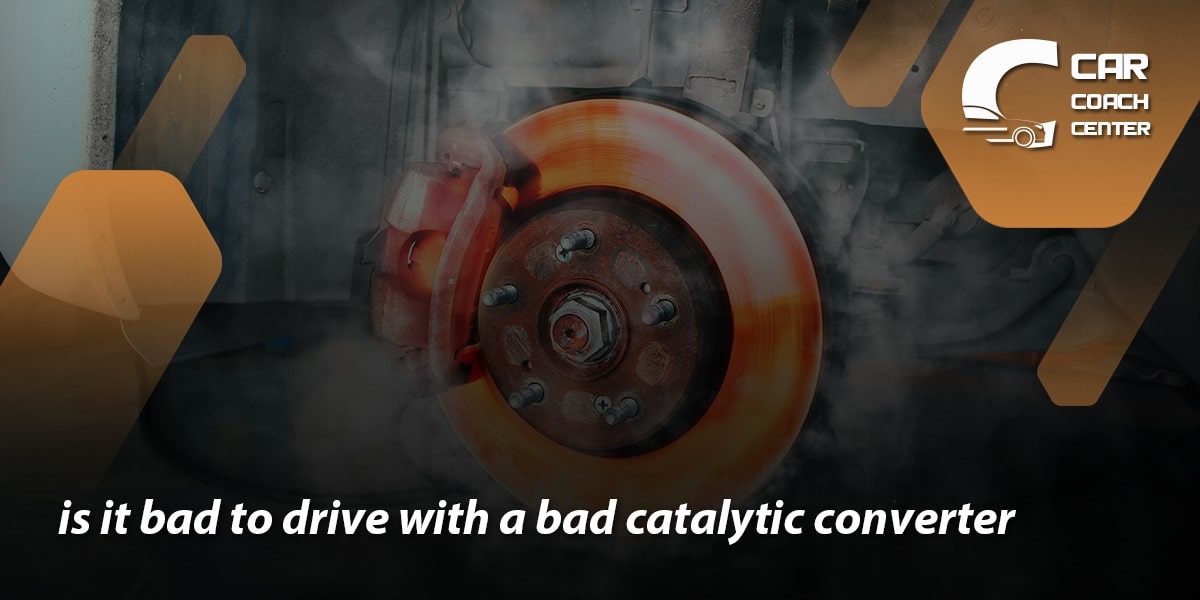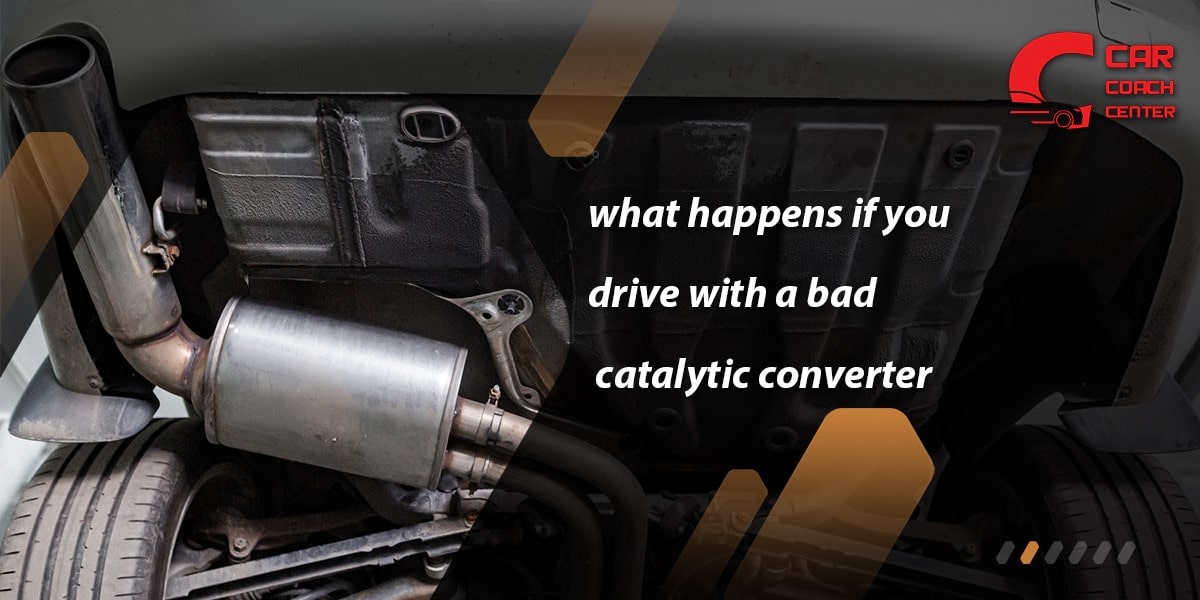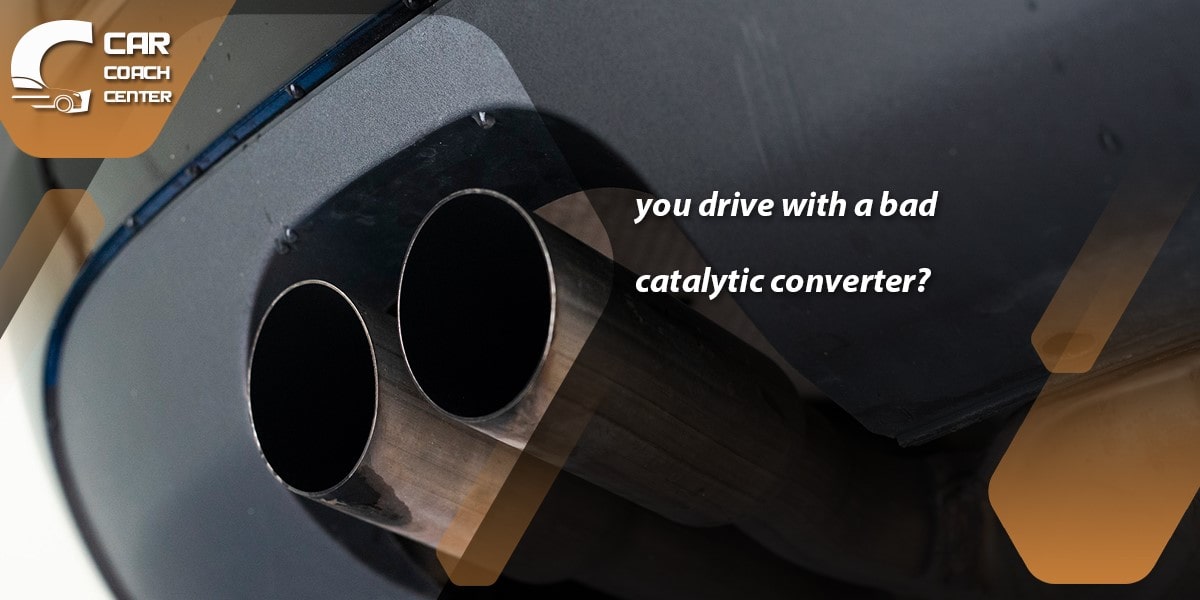Can you drive a car with a bad catalytic converter?
Can you drive with a bad catalytic converter? It’s a question that often arises when faced with the prospect of dealing with a failing emission control device in your vehicle. The catalytic converter plays a crucial role in reducing harmful emissions, converting them into less harmful substances before they are released into the atmosphere.

However, when this essential component malfunctions or becomes damaged, it can raise concerns about the safety, performance, and legal implications of driving with a faulty catalytic converter. In this article, we will explore catalytic converters’ function, signs of failure, impact on vehicle performance, legal and environmental consequences, temporary solutions, and repair options.
By understanding the implications and available choices, you can make informed decisions about whether it is safe and advisable to continue driving with a bad catalytic converter or if immediate repair or replacement is necessary to ensure your car’s efficiency, environmental friendliness, and compliance with regulations.
The Role of the Catalytic Converter: Exploring its Function and Importance
The catalytic converter is a critical component in the modern automobile’s exhaust system, pivotal in reducing harmful emissions. Its primary function is to convert toxic gases produced by the engine, such as carbon monoxide, nitrogen oxides, and hydrocarbons, into less harmful substances before they are released into the atmosphere. This emission control device accomplishes this through a series of chemical reactions within its structure.
Typically located between the engine and the muffler, the catalytic converter contains a catalyst made of precious metals, such as platinum, palladium, and rhodium. As exhaust gases pass through the converter, the catalyst facilitates chemical reactions that break down harmful pollutants. Carbon monoxide is converted into carbon dioxide; nitrogen oxides are transformed into nitrogen and oxygen, and unburned hydrocarbons are oxidized into carbon dioxide and water vapor.
Given its vital role in emissions reduction, a functioning catalytic converter is of utmost importance not only for environmental reasons but also for complying with emissions regulations in many jurisdictions. However, a common concern arises when the catalytic converter malfunctions or becomes clogged due to age, wear and tear, or other issues. Can you drive with a bad catalytic converter? The answer is complex.
While it may be tempting to continue driving with a failing catalytic converter, it is essential to understand the potential consequences. A malfunctioning converter can lead to decreased fuel efficiency, reduced engine performance, and increased harmful emissions. Moreover, ignoring the problem may damage other engine components, such as oxygen sensors and the engine itself, leading to costly repairs.
In addition to the performance and financial implications, driving with a bad catalytic converter can have legal repercussions. Many countries and states have stringent emissions standards, and operating a vehicle with a non-compliant or malfunctioning catalytic converter can result in fines, penalties, or even vehicle impoundment.

Warning Signs of a Failing Catalytic Converter: How to Identify the Problem
Recognizing the warning signs of a failing catalytic converter is crucial in determining whether you can continue driving with it or if immediate attention is required. While the symptoms may vary depending on the extent of the problem, there are several common indicators to watch out for.
One of the primary signs of a malfunctioning catalytic converter is a noticeable decrease in engine performance. You may experience a lack of power during acceleration or difficulty reaching higher speeds. This can be attributed to a restriction in the exhaust system caused by a clogged or damaged converter.
Another telltale sign is a significant drop in fuel efficiency. A failing catalytic converter can disrupt the combustion process, leading to inefficient fuel use. It could be a sign of a deteriorating converter if you notice that you’re visiting the gas station more frequently despite driving under normal conditions.
Additionally, a malfunctioning catalytic converter often triggers the illumination of the check engine light on your dashboard. Modern vehicles have onboard diagnostic systems that monitor various components, including the catalytic converter. If the system detects irregularities or decreases catalytic converter efficiency, it will trigger the check engine light to alert you of a potential problem.
Another clue to a failing catalytic converter is the exhaust’s sulfuric or rotten egg smell. This odor is often caused by the buildup of sulfur compounds due to inefficient catalytic conversion. If you notice this distinct smell lingering around your vehicle after running, it could indicate a faulty converter.
The Impact of a Faulty Catalytic Converter on Vehicle Performance: What to Expect
Driving with a bad catalytic converter can significantly impact your vehicle’s performance, affecting various aspects of its operation. Understanding these effects is crucial in determining whether it is safe and advisable to continue driving with a faulty converter.
One of the primary consequences of a failing catalytic converter is a noticeable decrease in engine performance. The converter is vital in maintaining proper exhaust flow and reducing back pressure. However, when the converter becomes clogged or damaged, exhaust gases are restricted from exiting the engine efficiently.
This restriction reduces power during acceleration, sluggish response, and difficulty reaching higher speeds. If your vehicle struggles to perform as it used to or lacks the usual smoothness in operation, it may be due to a faulty catalytic converter.
In addition to decreased engine performance, a failing catalytic converter can also result in poor fuel efficiency. The converter’s function is to facilitate the conversion of harmful gases into less harmful substances, ensuring optimal combustion and efficient fuel usage.
However, when the converter fails, the combustion process can be disrupted, leading to incomplete fuel burning and decreased fuel efficiency. A faulty converter could be the culprit if you notice a significant drop in your vehicle’s miles per gallon (MPG) despite driving under normal conditions.

Furthermore, a malfunctioning catalytic converter can trigger the illumination of the check engine light on your dashboard. Modern vehicles have onboard diagnostic systems that monitor various components, including the catalytic converter.
When the system detects irregularities or decreases in converter efficiency, it signals the check engine light to alert you of a potential problem. Ignoring this warning can lead to further damage to the engine and other components, so it is important to address the issue promptly.
Legal and Environmental Consequences of Driving with a Bad Catalytic Converter
Driving with a bad catalytic converter poses risks to your vehicle’s performance and carries potential legal and environmental consequences. It is important to be aware of these implications to make informed decisions regarding the operation of your vehicle.
From a legal standpoint, many countries and states have strict emissions regulations to protect the environment and public health. These regulations often require vehicles to have properly functioning catalytic converters that meet specific emission standards. Operating a vehicle with a non-compliant or malfunctioning catalytic converter can result in fines, penalties, or impoundments. Law enforcement agencies and transportation authorities can conduct emissions tests and inspections to ensure compliance. Therefore, driving with a bad catalytic converter can lead to legal troubles and financial burdens.
In addition to the legal consequences, a faulty catalytic converter can harm the environment. The primary purpose of the converter is to reduce harmful emissions by converting toxic gases into less harmful substances. When the converter is not functioning properly, these pollutants, such as carbon monoxide, nitrogen oxides, and hydrocarbons, are released into the atmosphere at higher levels.
This contributes to air pollution, smog formation, and negative impacts on air quality. Considering the global focus on environmental conservation and sustainability, driving with a bad catalytic converter goes against efforts to reduce emissions and protect the planet.
Furthermore, it is worth noting that the continued operation of a vehicle with a malfunctioning catalytic converter can result in further damage to the environment by causing harm to other engine components. A failing converter can lead to improper combustion, increased stress on the engine, and potential engine damage. Repairs required to address these issues may involve additional resources, energy, and materials, further impacting the environment.

Repairing vs. Replacing: Exploring Your Options for Dealing with a Failing Catalytic Converter
When faced with a failing catalytic converter, you have two primary options: repairing or replacing the converter. Each option comes with its considerations, and the choice depends on various factors, such as the extent of the damage, cost, and availability of parts.
Repairing a catalytic converter is possible in certain cases, particularly when the issue is due to minor damage or a component that can be easily replaced. Common repairs may involve fixing exhaust leaks, replacing oxygen sensors, or addressing minor clogs. However, it is important to note that not all converters can be repaired, and the success of the repair depends on the specific problem.
On the other hand, replacing the catalytic converter is often the more recommended and reliable solution for significant or irreparable damage. When considering replacement, you have two options: original equipment manufacturer (OEM) converters or aftermarket converters.
OEM converters are produced by the same manufacturer that originally supplied the converter in your vehicle, ensuring compatibility and performance. Third-party manufacturers produce aftermarket converters and may offer cost savings. Still, ensuring they meet the necessary emission standards and are compatible with your vehicle is important.
When deciding between repair and replacement, consider your vehicle’s age and overall condition. Suppose your vehicle is older and has multiple components showing signs of wear. In that case, opting for a complete replacement rather than investing in repairs that only provide a temporary solution is more prudent.
It is worth noting that certain situations may require a catalytic converter replacement regardless of the damage. For example, if your vehicle has high mileage or has already undergone previous repairs on the converter, a replacement may be necessary for long-term reliability.
Regarding the legality of driving with a bad catalytic converter, ensuring that the replacement converter meets emissions regulations in your jurisdiction is important. Check with local authorities or consult a professional mechanic to ensure compliance with the applicable standards.
Can You Temporarily Drive with a Bad Catalytic Converter? Tips for Safe Navigation
If you find yourself with a bad catalytic converter, you may wonder if it is possible to temporarily drive your vehicle until you can address the issue properly. While it is generally not recommended to drive with a faulty converter, there are a few considerations and precautions you can take to navigate safely in the short term.
Understand the Risks
Driving with a bad catalytic converter can lead to decreased engine performance, reduced fuel efficiency, and potential damage to other engine components. Awareness of these risks and exercise of caution while driving are important.
Limit Driving Distance
If possible, restrict your driving to essential trips only. Minimizing your time on the road can mitigate potential issues and reduce the strain on the catalytic converter.
Avoid Aggressive Driving
Aggressive acceleration, hard braking, and excessive idling can put additional stress on the converter and exacerbate its malfunction. Opt for smooth and gentle driving techniques to lessen the strain on the exhaust system.
Monitor Engine Performance
Pay close attention to any changes in engine performance, such as reduced power or unusual noises. If you notice severe deterioration, please stop driving and seek professional assistance.
Stay Up to Date with Maintenance
Ensure that your vehicle’s overall maintenance is up to date. Regularly check and replace air filters, spark plugs, and oxygen sensors as your vehicle’s manufacturer recommends. Well-maintained components can help alleviate some of the stress on the catalytic converter.
Seek Professional Advice
Consult a qualified mechanic or automotive expert to assess the extent of the catalytic converter’s damage. They can provide insights into whether it is safe to continue driving temporarily or if immediate repair or replacement is necessary.
Remember, while these tips can assist in safe navigation with a bad catalytic converter, they are short-term solutions. Continuing to drive with a malfunctioning converter can lead to further damage and potential legal consequences. It is crucial to prioritize the repair or replacement of the catalytic converter as soon as possible to ensure your vehicle’s safe and efficient operation.
Conclusion
In conclusion, understanding the implications of driving with a bad catalytic converter is crucial for vehicle owners. While the initial question, “Can you drive with a bad catalytic converter?” may elicit mixed responses, it is evident that doing so poses risks to both vehicle performance and the environment. The drawbacks of driving with a faulty converter are significant, from decreased engine performance and poor fuel efficiency to potential legal consequences and increased emissions.
Therefore, addressing any issues promptly through repair or replacement is advisable. By visiting professional mechanics and seeking guidance, individuals can ensure their vehicles’ safe and efficient operation while complying with emissions regulations. For more information and expert advice on maintaining a healthy exhaust system and maximizing vehicle performance, visit carcouchcenter.com. Stay informed, prioritize sustainability, and make responsible choices to keep your vehicle and the environment in optimal condition.
Can you drive with a bad catalytic converter?
While it is possible to drive with a bad catalytic converter, it is not recommended due to potential risks to vehicle performance, increased emissions, and potential legal consequences.
What are the signs of a failing catalytic converter?
Signs of a failing catalytic converter include decreased engine performance, reduced fuel efficiency, illuminated check engine light, and a sulfuric odor from the exhaust.
Should I repair or replace my bad catalytic converter?
The decision to repair or replace a bad catalytic converter depends on the extent of the damage and the overall condition of your vehicle.


